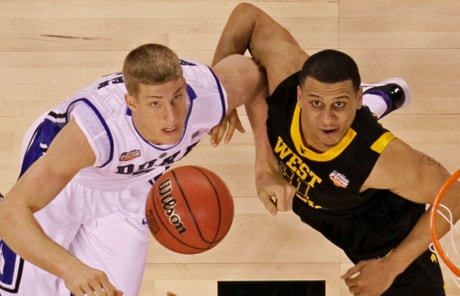INDIANAPOLIS — Yes, it’s a matchup pitting a cute bulldog against a devil, America’s favourite underdog against the team people love to hate.
Dig a little deeper, though, and basketball fans might see two programs, the Butler Bulldogs and Duke Blue Devils, who come from almost the same place.
The teams playing for the national championship tonight hail from small, private schools that don’t simply open their doors to anyone. They’re located in different parts of America, but both deep in the heart of basketball country — Indiana and North Carolina.
And if the Cameron Crazies — the (in)famous Duke student section that rarely fails to find something to dis — want to pick on Butler, best to leave the “Safety School” and “You’ll be working for us someday” banter on the sideline.
As is the case at Duke, Butler graduates about 90 per cent of its players. As is the case at Duke, there’s more than mere lip service paid to the classroom at Butler — no need to roll your eyes when the overused term “student-athlete” gets busted out this time of year by the NCAA.
“They’re all looking for special players and kids,” Butler athletic director Barry Collier said.
“The fit at Butler, there are players on our team that could play at lots of schools. We have tried to recruit students that were (true) student-athletes, basketball players who were very good students.”
Butler’s coach, Brad Stevens, is 33 — the same age Mike Krzyzewski was when he took over at Duke 30 years ago, back when both he and his school were something less than what they’ve become.
“I thought at the time Duke was one of the respected schools in the South. Over the last three decades, we’ve become one of the most respected schools in the world,” Krzyzewski said.
Coach K credits at least some of that to the exposure the basketball program has brought to the campus in Durham, N.C., over the years. Not impossible to think that might happen to Butler if it stays on the course it’s on.
Stevens followed the formula set up by his predecessors, Thad Matta and Todd Lickliter: Recruit team-oriented players with a sense of tradition who, maybe most importantly, want to get a degree.
“We always say that whatever happens on the basketball court, we don’t want it to be the highlight of your life,” Stevens said.
Sounds good, but let’s get real.
Win or lose Monday, Butler has made itself the centre of a once-in-a-generation sports story, where the overlooked team keeps knocking off giants — Syracuse, Kansas State, Michigan State — and now finds itself on the verge of capping off a Hoosiers rewrite.
The Bulldogs’ home, Hinkle Fieldhouse, a mere nine kilometres away from Lucas Oil Stadium in Indy, has long been as much a tourist attraction to the hoops blueblood as Duke’s Cameron Indoor Stadium is on Tobacco Road.
The rafters at Cameron, however, are covered with names such as Battier, Hill and Laettner, while the ceilings at Hinkle are layered with a thin coat of dust, along with the memories of tiny Milan High School, the 1954 state high school champions featuring Bobby Plump, whose character became Jimmy Chitwood in the movie.
“I think we embrace it,” Butler forward Gordon Hayward said. “If that’s what the story is going to be, we’ll accept that. We’re up for the challenge . . . Once the ball goes up in the air, all that’s going to disappear, and it’s just 5-on-5. We view them as another opponent, someone we’re going to play and try to beat.”
In a sign of how far Butler has come, the Bulldogs (33-4) might have the best NBA prospect on the floor Monday night in Hayward, a six-foot-nine forward, who can shoot the three, guard on the perimeter and play in the middle if he has to.
Giving him a run for his money is Duke’s Kyle Singler, who along with Jon Scheyer and Nolan Smith, make up the “Big Three” for the Blue Devils (34-5) — three players who will play at the next level, but not before sticking around college for a while.
“Everybody wants to be like them,” Stevens said. “I don’t think there’s any question. Speaking for Butler, we have a tremendous program, but we’re not near what Duke has accomplished over the last 30-plus years. They’ve set a standard.”
